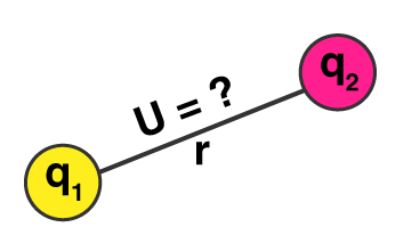Electric Potential and Energy
What is Electric Potential Energy?
The electric potential energy of any given charge or system of changes is termed as the total work done by an external agent in bringing the charge or the system of charges from infinity to the present configuration without undergoing any acceleration.
Definition: Electric potential energy is defined as the total potential energy a unit charge will possess if located at any point in the outer space.
In an electrical circuit, the potential between two points (E) is defined as the amount of work done (W) by an external agent in moving a unit charge (Q) from one point to another.
Mathematically we can say that,
E = W/Q
Where,
- E = electrical potential difference between two points,
- W = Work done in moving a change from one point to another,
- Q = Quantity of charge in coulombs.
Electric Potential Formula:
A charge placed in an electric field possesses potential energy and is measured by the work done in moving the charge from infinity to that point against the electric field. If two charges q1 and q2 are separated by a distance d, the electric potential energy of the system is;
U = 1/(4πεo) × [q1q2/d]
If two like charges (two protons or two electrons) are brought towards each other, the potential energy of the system increases. If two unlike charges i.e. a proton and an electron are brought towards each other, the electric potential energy of the system decreases.
The electric potential at any point around a point charge q is given by:
V = k × [q/r]
Where,
- V = electric potential energy,
- q = point charge,
- r = distance between any point around the charge to the point charge,
- k = Coulomb constant; k = 9.0 × 109 N.

We know that a body raised above the ground level has a certain amount of mechanical potential energy which, by definition, is given by the amount of work done in raising it to that height. If, for example, a body of 5 kg is raised against gravity through 10 m, then the potential energy of the body is 5 × 10 = 50 m-kg.
wt. = 50 × 9.8 = 490 joules.
The body falls because there is attraction due to gravity and always proceeds from a place of higher potential energy to one of lower potential energy. So, we speak of gravitational potential energy or briefly ‘potential’ at different points in the earth’s gravitational field. Now, consider an electric field. Imagine an isolated positive charge Q placed in air (Figure given below). Like earth’s gravitational field, it has its own electrostatic field which theoretically extends upto infinity. If the charge X is very far away from Q, say, at infinity, then force on it is practically. zero. As X is brought nearer to Q, a force of repulsion acts on it (as similar charges repel each other), hence work or energy is required to bring it to a point like A in the electric field. Hence, when at point A, charge X has some amount of electric potential energy. Similar other points in the field will also have some potential energy. In the gravitational field, usually ‘sea level’ is chosen as the place of ‘zero’ potential. In electric field infinity is chosen as the theoretical place of ‘zero’ potential although, in practice, earth is chosen as ‘zero’ potential, because earth is such a large conductor that its potential remains practically constant although it keeps on losing and gaining electric charge every day.

Electric Potential Derivation
Let us consider a charge q1. Let us say, they are placed at a distance ‘r’ from each other. The total electric potential of the charge is defined as the total work done by an external force in bringing the charge from infinity to the given point.
We can write it as, -∫ (ra→rb) F.dr = – (Ua – Ub)
Here, we see that the point rb is present at infinity and the point ra is r.
Substituting the values we can write, -∫ (r →∞) F.dr = – (Ur – U∞)
As we know that Uinfity is equal to zero.
Therefore, -∫ (r →∞) F.dr = -UR
Using Coulomb’s law, between the two charges we can write:
⇒ -∫ (r →∞) [-kqqo]/r2 dr = -UR
Or, -k × qqo × [1/r] = UR
Therefore, UR = -kqqo/r
Electric Potential of a Point Charge
Let us consider a point charge ‘q’ in the presence of another charge ‘Q’ with infinite separation between them.
UE (r) = ke × [qQ/r]
where, ke = 1/4πεo = Columb’s constant
Let us consider a point charge ‘q’ in the presence of several point charges Qi with infinite separation between them.
UE (r) = ke q × ∑ni = 1 [Qi /ri]
Read article – Units of Resistivity
Visit NCERTplanet.com for NCERT solutions and Textbook downloads




